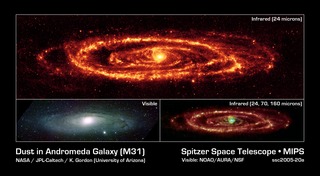
Credit: NASA/JPL-Caltech/K. Gordon (University of Arizona)
Observation • October 13th, 2005 • ssc2005-20a2
ssc2005-20a2
NASA's Spitzer Space Telescope has captured stunning infrared views of the famous Andromeda galaxy to reveal insights that were only hinted at in visible light.
The multi-wavelength view of Andromeda combines images taken at 24 microns (blue), 70 microns (green), and 160 microns (red). Using all three bands from the multiband imaging photometer allows astronomers to measure the temperature of the dust by its color. The warmest dust is brightest at 24 microns while the coolest is most evident at 160 microns. The blue/white areas have the hottest dust, as seen in the bulge and in the star-forming areas along the arms. The cooler dust floating further out in the ring and arms are in the redder regions.
The data were taken on August 25, 2004, the one-year anniversary of the launch of the space telescope. The observations have been transformed into this remarkable gift from Spitzer -- the most detailed infrared image of the spectacular galaxy to date.
About the Object
- Name
- Andromeda Galaxy • Messier 31 • M31 • NGC 224
- Type
- Galaxy > Type > Spiral
- Distance
- 2,500,000 Light Years
Color Mapping
| Band | Wavelength | Telescope |
| Infrared | 24.0 µm | Spitzer MIPS |
| Infrared | 70.0 µm | Spitzer MIPS |
| Infrared | 160.0 µm | Spitzer MIPS |
Astrometrics
- Position (J2000)
- RA =0h 42m 44.3s
- Dec = 41° 16' 6.2"
- Field of View
- 2.8 x 0.8 degrees
- Orientation
- North is 53.0° left of vertical







